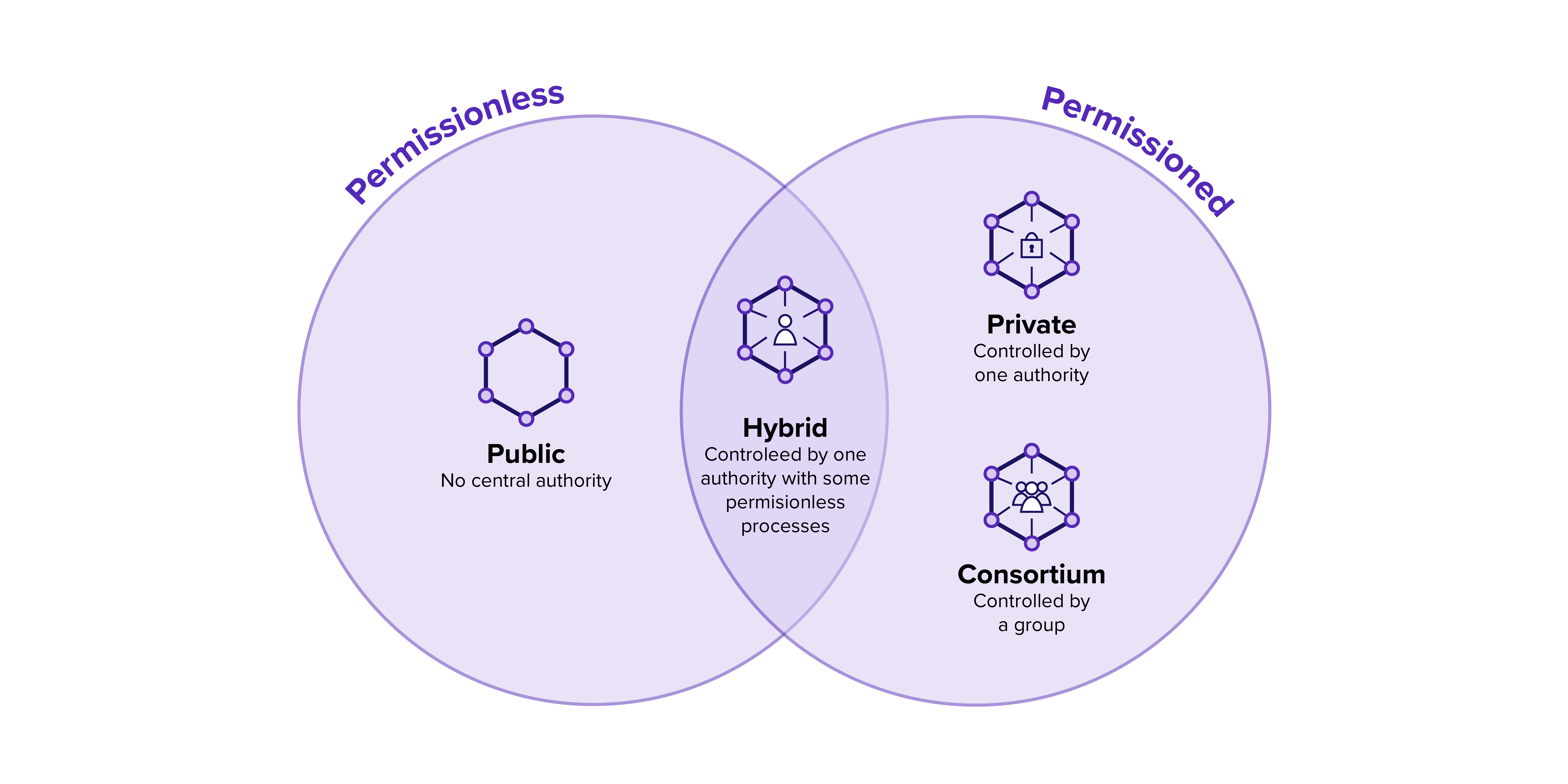The 4 types of Blockchain and why you should know the difference
There are four main types of blockchain; public, private, hybrid, and consortium. Each of these blockchains has its own benefits and downsides, along with its ideal use. Whether you're planning a career working in Web3, investing in projects, or just a fan of the space, it's important you understand the difference between the four. So, let's dive straight in.

Parcl Team
Aug 1, 2022
Introduction
There are four main types of blockchain; public, private, hybrid, and consortium. Each of these blockchains has its own benefits and downsides, along with its ideal use. Whether you're planning a career working in Web3, investing in projects, or just a fan of the space, it's important you understand the difference between the four. So, let's dive straight in.
The Four Main Types of Blockchain
1) Public Blockchain
A public blockchain is the most widely used within the Web3 industry. Bitcoin operates within a public blockchain, and it was this cryptocurrency that helped pave the way for distributed ledger technology into the mainstream. Public blockchains fix common centralization problems by providing greater transparency and better security.

DLT won't store information in one place; by keeping it distributed across a peer-to-peer network, this decentralized system provides effective security. A public ledger uses a decentralized method of verifying the authenticity of data; this is done using a consensus algorithm to reach an agreement. Proof of Work (PoW) and Proof of Stake (PoS) are the two most common consensus algorithms.
A public blockchain is considered a non-restrictive and permissionless ledger, and anyone can use it by using a blockchain platform to become an authorized node. By using the public blockchain node, you'll have access to current and past transactions, mine cryptocurrency, verify transactions, and propose changes.
Although public blockchains are known to be slower than their centralized counterparts, this isn't always the case. The speed tends to depend on which consensus algorithm the particular network is using.
Advantages
Due to this blockchain being open to anyone, no single entity has full control over the permissions or ability to access information stored on the ledger. Public blockchains are fully transparent and are relatively secure.
Disadvantages
Due to their size, public blockchains are quite slow at processing transactions and have poorer scalability options. However, this isn't always the case, as this also depends on the consensus mechanism. In terms of security, if hackers gained 51% control of the network by controlling nodes, they could alter the network; this isn't an easy task to achieve but is still possible.
Use cases
Public blockchains are primarily known to be better alternatives to hold public records such as government spending, verifying property ownership and can even be used for notarization of affidavits. Ideally, public blockchains can be used by institutions that want to ensure transparency with their stakeholders, such as governments or charities.
2) Private Blockchain
A private blockchain is more restrictive and isn't open to the general public. These blockchains are controlled by a single entity. A private blockchain operates just as a public one would, with peer-to-peer connections, and is decentralized; the only catch is that it works on a smaller scale within a particular organization. Think of a private blockchain like intranet but much more advanced.

Advantages
The organization controls permissions, security, authorizations, and accessibility. This also goes for the authority of nodes which is decided by the entity. The benefit of this more restrictive blockchain is that it prevents third parties from accessing certain information, which is handy in certain use cases. Due to their smaller scale, private blockchains can be much faster at processing transactions than their public counterparts.
Disadvantages
Private blockchains aren't considered to be real blockchains in theory. The point of a blockchain is mainly built upon the idea that it has to be fully decentralized.
Due to the more centralized control of a private blockchain, it can be argued that they're not as trustworthy due to the fact that the nodes that determine the validity of information are controlled by a single entity.
The reduction in the number of nodes is also a concern, as this means it'd be easier for hackers to gain control over the consensus mechanism. Another concern is that due to the source code being closed from the public, it can't be independently verified.
Use cases
The speed of private blockchains could be a huge benefit and ideal for certain businesses that need the information to be cryptographically secure but also private and closed from the public, such as census records medical records and taking advantage of the benefits of blockchain technology without releasing their trade secrets to the public and competitors. Other use cases include supply chain management and internal voting.
3) Hybrid Blockchain
A hybrid blockchain combines features from both private and public blockchain. Organizations will be allowed to set up a private, permission-based system alongside a public permissionless one.

With private blockchains, the data is closed off to the public, but with a hybrid, the organization can decide which data is accessible to the public and controls who can access the data.
Transactions would typically be made private on a hybrid blockchain, but they can be verified if needed by allowing access by an external smart contract that could verify the information.
A hybrid blockchain makes it possible for private yet verifiable transactions that cannot be altered by the organization.
Users can fully operate on a hybrid blockchain with anonymity until the point of transaction, with their identity then being revealed to the other party.
Advantages
The greatest advantage of a hybrid blockchain is that it operates within a closed system, meaning that hackers can take control via a 51% attack on the network. But, although it works within a closed ecosystem, the information can still be shared and verified by third parties. Transactions using a hybrid blockchain are typically cheaper, faster, and better scalability options than a public blockchain.
Disadvantages
Although it's less closed off than a private blockchain, the data can still be shielded from third parties; it's not completely transparent but could be ideal for certain use cases.
Use cases
Hybrid blockchain could be of use in many areas such as real estate as they'll have somewhere to store data while showing only certain information such as listings to the general public. Blockchain could also be used to streamline processes in the hospitality and retail sectors.
Any sector that deals with sensitive information but still wants to offer transparency through verification could benefit from this type of blockchain. Medical records are also another way a hybrid blockchain could be used.
4) Consortium Blockchain
The fourth and final type of blockchain on our list is the consortium blockchain, also referred to as a federated blockchain. Similar to the hybrid blockchain but different in that the organization's members work on a decentralized network. In summary, it's a private blockchain, but grants access to a particular group rather than a single entity, meaning less risk of an individual controlling the entire network.
In a consortium blockchain, the consensus procedures are controlled by preset nodes. It has a validator node that initiates, receives, and validates transactions. Member nodes can receive or initiate transactions.
Advantages
A greater option for security, scalability, and efficiency compared to a public network. Similar to the private and hybrid options but it offers more control to a larger group of people.
Disadvantages
A consortium blockchain is less transparent than a public blockchain. It can still be compromised if a member node is breached; the blockchain's own regulations can impair the network's functionality.
Use cases
Banking and payments are two uses for this type of blockchain. Different banks can band together and form a consortium, deciding which nodes will validate the transactions. Research organizations can create a similar model, as can organizations that want to track food. It's ideal for supply chains, particularly food and medicine applications.
Closing
While these are the four main types of blockchain, there are also consensus algorithms to consider.
Ultimately, blockchain technology is becoming more popular and rapidly gaining enterprise support. Every one of these types of blockchain has potential applications that can improve trust and transparency and create a better record of transactions.
Follow us
🌐 Join our Waitlist: https://parcl.co
🐤 Twitter: https://twitter.com/Parcl
🏡 Discord: https://discord.gg/zWxp2JupNA
Shared content and posted charts are intended to be used for informational and educational purposes only. Parcl does not offer, and this information shall not be understood or construed as, financial advice or investment recommendations. The information provided is not a substitute for advice from an investment professional. Parcl does not accept liability for any financial loss or damages. For more information please see the terms of use.

Parcl Team



